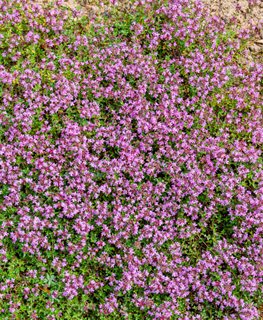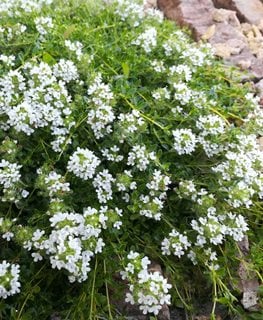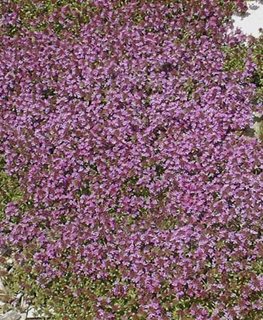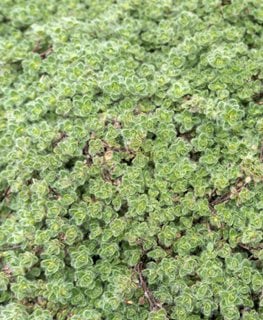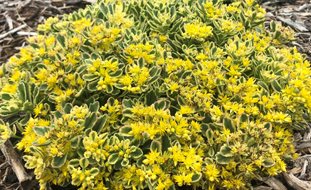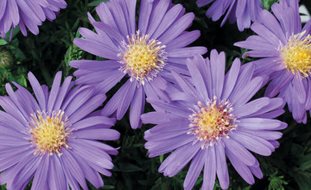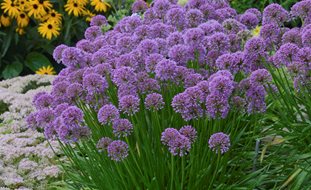Creeping Thyme: Tips for Growing, Caring For, and Planting
Learn about the many charms of this resilient, aromatic groundcover.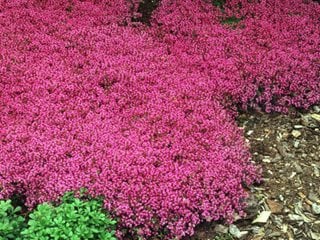
Red creeping thyme. Photo by: Proven Winners
If you’ve only thought of thyme as a plant for the herb garden, you may be surprised to discover that there are also several creeping varieties valued more for their ornamental attributes than their culinary qualities.
Forming a dense, ground-hugging mat of tiny evergreen leaves, creeping thyme is ideal for use as a foot-friendly groundcover to fill gaps between stepping stones and patio pavers, where the foliage will release its heady herbal scent whenever you tiptoe through it.
Because of its ability to withstand moderate foot traffic, creeping thyme can also be used as an easy-care lawn substitute, especially on sunny hillsides and slopes. Not only does this drought-tolerant perennial require much less water than traditional turf grass, it also spreads quickly to fill in bare spots. As a bonus, creeping thyme creates a colorful floral carpet in late spring, when it bursts into a profusion of dainty pink or purple flowers.
On this page: Basics | Planting | Care | Pictures | Landscaping Ideas
On this page:
- BASICS
- HOW TO PLANT CREEPING THYME
- CREEPING THYME CARE AND MAINTENANCE
- CREEPING THYME VARIETIES
- DESIGN IDEAS
CREEPING THYME BASICS
Botanical name:
Thymus spp.
Common names:
Creeping thyme, mother of thyme, wild thyme
Plant type:
Semi-woody perennial groundcover
Zones:
4-9
Exposure:
Full sun
Height/Spread:
1 to 4 inches tall, spreading up to 18 inches. Plants may be slightly taller when in bloom.
Bloom time:
Late spring to early summer, with the blooms lasting for 3 to 4 weeks. Plants may not flower during their first growing season because they will be focusing all their energy on root development. However, they should flower prolifically the following spring.
Flowers:
Star- or bell-shaped, measuring about 1/8 inch across. Usually in shades of pink or purple, although some cultivars have red or white blooms.
Foliage:
Slightly hairy and elliptical, growing to 1/4 inch in length. May be dark green, olive green, or gray-green, depending on the cultivar. Often semi-evergreen or evergreen in areas with mild winters.
Method of spreading:
By trailing stems that sprawl out horizontally from a central root system. The stems take root where they come in contact with the soil, with new shoots forming at the point where rooting occurs. Though it can spread quickly once established, creeping thyme is not invasive and easy to manage.
Special attributes:
- Drought tolerant
- Attracts bees and butterflies
- Rabbit and deer resistant
- Non-toxic to people and pets
Is creeping thyme edible?
Although both the flowers and leaves are edible, they are generally not used for cooking because the fragrance and flavor are inconsistent. Common thyme (Thymus vulgaris) is a better choice for culinary purposes.
HOW TO PLANT CREEPING THYME
When to plant:
In spring, after the threat of frost has passed, or in early fall. Avoid planting during the heat of the summer, when it’s difficult for plants to become established.
Where to plant:
A site that receives full sun (at least 6 hours daily) is best for optimal flowering, but plants will also tolerate light shade.
How to plant:
May be started from seeds or nursery starts. Sow seeds indoors in early spring or directly outdoors after the danger of frost has passed. It typically takes 2 to 3 weeks for thyme seeds to germinate. (Get these tips for growing plants from seeds.)
To transplant thyme into the garden, dig a hole a bit wider and slightly shallower than the rootball. Carefully untangle the roots and set the plant into its hole, gently filling the soil back around the roots until they are completely covered. Water thoroughly and maintain consistent soil moisture until plants become established.
Soil requirements:
Creeping thyme thrives in sandy, silty, or rocky soils that provide excellent drainage. Will also tolerate poor soil, but avoid planting in heavy clay or in low spots prone to standing water.
Spacing:
Spacing often depends on how quickly you want the area to fill in with growth. As a general rule of thumb, space plants about 8 to 12 inches apart to accommodate their spreading habitat. If using creeping thyme as a lawn substitute, closer spacings will provide denser, more even coverage.
Growing in containers:
If planting creeping thyme in containers or window boxes, it’s essential to use a high-quality potting mix with good drainage. If necessary, add horticultural sand or perlite to the mix to help improve water flow and keep plants from getting wet feet.
CREEPING THYME CARE
Watering:
Although creeping thyme is drought tolerant, you should water new plants regularly until the roots become established, keeping the soil evenly moist but not soggy. After the first year, supplemental watering should only be needed during prolonged periods without rainfall. To prevent root rot, avoid overwatering and never allow plants to sit in standing water.
Amendments & fertilizer:
If necessary, lightly amend the soil with compost, leaf mold, or other organic matter to help loosen the structure and improve drainage. Because creeping thyme thrives in lean soil, additional fertilization is generally not necessary. If the soil is especially nutrient deficient, you can apply a balanced organic fertilizer in spring to help stimulate lush, new growth.
Pruning:
Because of their woody stems, creeping thyme plants can become very spindly and woody at the base over time. To rejuvenate your plants and generate fresh, new growth, cut them back by half in early spring before new growth begins.
Deadheading:
Although you don’t have to deadhead thyme flowers, shearing the spent blooms in midsummer using hand or electric shears will keep your plants looking tidy. For creeping thyme lawns, you can use mower blades set to a height of 2 to 3 inches to remove the spent flowers.
Overwintering:
In temperate climates, creeping thyme will usually remain evergreen throughout the winter. In regions where winters are cold, plants may lose their foliage, but it will quickly grow back the following spring.
To prevent frost or freeze damage during the winter months, cover creeping thyme with several inches of a loose mulch, such as leaf mold. This can help prevent frost heaving of the plant’s shallow root system.
Propagation:
By division in the spring or late fall or by stem cuttings taken in late spring or early summer.
Diseases and pests:
Has few pest or disease problems, but is vulnerable to root rot if grown in areas with poor drainage. Also be on the lookout for spider mites in hot, dry conditions.
CREEPING THYME VARIETIES
CREEPING THYME LANDSCAPING TIPS
In addition to its use as an ornamental groundcover or lawn substitute, creeping thyme has many other applications in the garden:
- Use alongside a sidewalk or garden pathway, where the flowing foliage can soften the hard edges and add wonderful color and scent.
- A rock garden is also an excellent site for this meandering plant. Or allow it to cascade over retaining or rock walls to create vertical interest. (Learn more about vertical gardening.)
- Use as a pretty border around a vegetable garden to create nice visual and textural contrast. As a bonus, creeping thyme attracts beneficial insects, repels cabbage worms, and deters rabbits.
- Allow to trail from sunny window boxes or patio planters, where the lovely herbal aroma can be appreciated at close range.
- Combine with other drought-tolerant, sun-loving perennials to create a waterwise landscape. (See these drought-tolerant garden ideas.)

